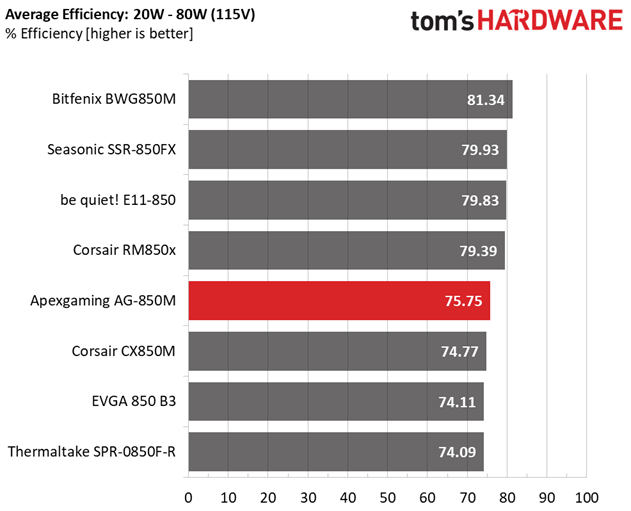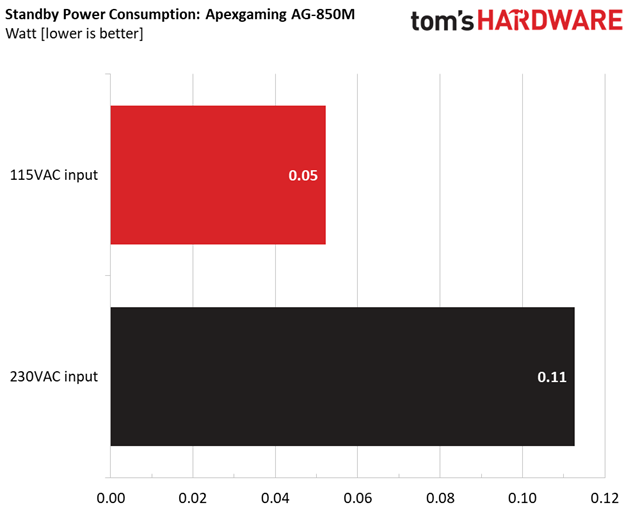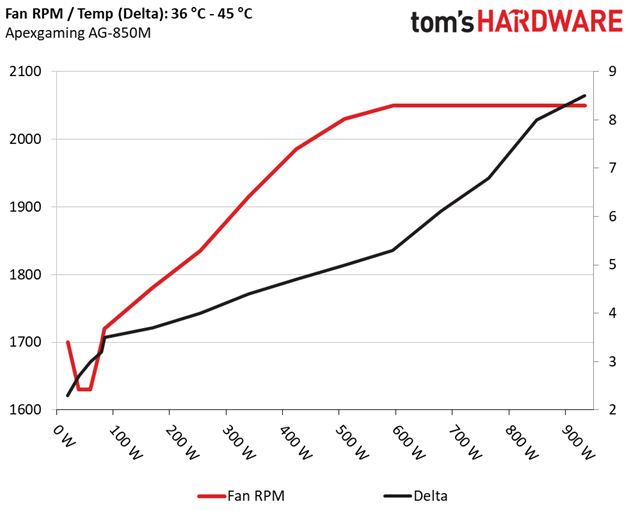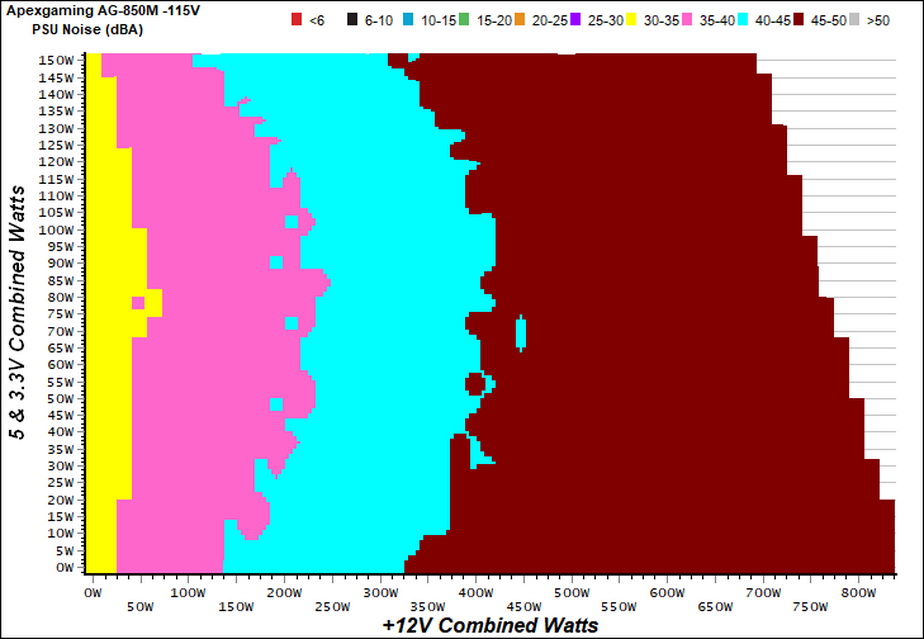Apexgaming AG-850M PSU Review
Why you can trust Tom's Hardware
Efficiency, Temperature & Noise
Efficiency
Our efficiency testing procedure is detailed here.
Using results from the previous page, we plotted a chart showing the AG-850M’s efficiency at low loads, and loads from 10 to 110 percent of its maximum-rated capacity.




Under normal loads, the AG-850M follows Corsair's RM850x. With light loads, the difference between those two power supplies is large.
Efficiency At Low Loads
In the following tests, we measure the AG-850M's efficiency at loads significantly lower than 10 percent of its maximum capacity (the lowest load the 80 PLUS standard measures). The loads we dialed were 20, 40, 60, and 80W. This is important for representing when a PC is idle, with power-saving features turned on.
| Test # | 12V | 5V | 3.3V | 5VSB | DC/AC (Watts) | Efficiency | Fan Speed | PSU Noise | PF/AC Volts |
|---|---|---|---|---|---|---|---|---|---|
| 1 | 1.208A | 0.491A | 0.476A | 0.196A | 19.705 | 62.913% | 1780 RPM | 45.2 dB(A) | 0.876 |
| 12.086V | 5.098V | 3.363V | 5.112V | 31.321 | 115.10V | ||||
| 2 | 2.442A | 0.981A | 0.980A | 0.391A | 39.783 | 75.502% | 1630 RPM | 42.9 dB(A) | 0.948 |
| 12.082V | 5.092V | 3.360V | 5.095V | 52.691 | 115.10V | ||||
| 3 | 3.677A | 1.467A | 1.489A | 5.079A | 59.864 | 81.132% | 1615 RPM | 42.3 dB(A) | 0.970 |
| 12.077V | 5.085V | 3.355V | 5.079V | 73.786 | 115.10V | ||||
| 4 | 4.905A | 1.966A | 1.968A | 0.789A | 79.789 | 83.467% | 1675 RPM | 44.0 dB(A) | 0.976 |
| 12.073V | 5.078V | 3.350V | 5.063V | 95.594 | 115.10V |
The fan profile is out of this world; even under 20W of load, the blades spin at 1780 RPM, making a ton of noise. Stranger still is that, in the next two tests, the fan speed drops a bit, increasing again by the fourth test.
In general, this PSU's efficiency is low under light loads. It's only during the third test that the AG-850M exceeds 80%. Surely a high fan speed plays a significant role. After all, a few watts have a big impact on our efficiency calculation when the power supply isn't doing much otherwise.
5VSB Efficiency
The ATX specification, along with CEC, ErP Lot 3 2014 and ErP Lot 6 2010/2013, states that 5VSB standby supply efficiency should be as high as possible, recommending 75 percent or higher with 550mA, 1A, and 1.5A of load. The PSU should also achieve higher than 75% efficiency at 5VSB under full load, or with 3A if its max current output on this rail is higher than 3A.
Get Tom's Hardware's best news and in-depth reviews, straight to your inbox.
We take six measurements: one each at 100, 250, 550, 1000, and 1500mA, and one with the full load the 5VSB rail can handle.
| Test # | 5VSB | DC/AC (Watts) | Efficiency | PF/AC Volts |
|---|---|---|---|---|
| 1 | 0.101A | 0.519 | 68.651% | 0.076 |
| 5.122V | 0.756 | 115.07V | ||
| 2 | 0.251A | 1.284 | 75.618% | 0.153 |
| 5.109V | 1.698 | 115.07V | ||
| 3 | 0.542A | 2.755 | 79.144% | 0.245 |
| 5.085V | 3.481 | 115.07V | ||
| 4 | 1.002A | 5.056 | 79.785% | 0.314 |
| 5.046V | 6.337 | 115.07V | ||
| 5 | 1.502A | 7.514 | 79.329% | 0.351 |
| 5.004V | 9.472 | 115.07V | ||
| 6 | 3.001A | 14.623 | 75.920% | 0.403 |
| 4.873V | 19.261 | 115.07V |


The 5VSB rail demonstrates decent efficiency.
Power Consumption In Idle And Standby
In the table below, you'll find the power consumption and voltage values of all rails (except -12V) when the PSU is idle (powered on, but without any load on its rails), and the power consumption when the PSU is in standby mode (without any load, at 5VSB).
| Mode | 12V | 5V | 3.3V | 5VSB | Watts | PF/AC Volts |
|---|---|---|---|---|---|---|
| Idle | 12.090V | 5.102V | 3.366V | 5.130V | 8.410 | 0.483 |
| 115.1V | ||||||
| Standby | 0.047 | 0.005 | ||||
| 115.1V |


This PSU's power requirements in standby mode are low.
Fan RPM, Delta Temperature, And Output Noise
Our mixed noise testing is described in detail here.
The first chart below illustrates the cooling fan's speed (in RPM), and the delta between input and output temperature. The results were obtained at 36°C (96.8°F) to 45°C (113°F) ambient temperature.
The next chart shows the cooling fan's speed (again, in RPM) and output noise. We measured acoustics from one meter away, inside a hemi-anechoic chamber. Background noise inside the chamber was below 6 dB(A) during testing (it's actually much lower, but our sound meter’s microphone hits its floor), and the results were obtained with the PSU operating at 36°C (96.8°F) to 45°C (113°F) ambient temperature.
The following graph illustrates the fan's output noise over the PSU's operating range. The same conditions of the above graph apply to our measurements, though the ambient temperature was between 30°C (86°F) to 32°C (89.6°F).
An overzealous fan profile is this PSU's most obvious flaw. Even in normal ambient conditions, the fan starts with over 30 dB(A) of noise and quickly enters the 35-40 dB(A) range. With higher than 140W load it exceeds 40 dB(A), and above 320W it passes the 45 dB(A) mark.
MORE: Best Power Supplies
MORE: How We Test Power Supplies
MORE: All Power Supply Content
Current page: Efficiency, Temperature & Noise
Prev Page Load Regulation, Hold-Up Time & Inrush Current Next Page Protection Features
Aris Mpitziopoulos is a contributing editor at Tom's Hardware, covering PSUs.


